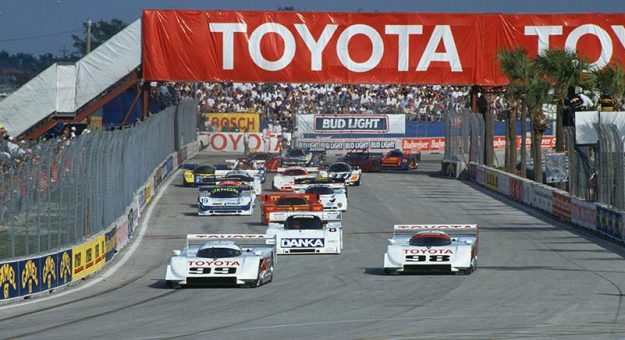DAYTONA BEACH, Fla. – The news was met with smiles – even audible cheers – from the audience on the eve of the Rolex 24 At Daytona at Daytona International Speedway.
GTP is back, IMSA President John Doonan announced with a wide grin on Jan. 27. The beloved racing classification that designated IMSA’s premier series class during the 1980s and early 1990s prototype heyday will be used again next year as a new platform makes its competitive debut at the Rolex 24 in 2023.
Beginning then, the Le Mans Hypercar (LMH) prototypes currently competing in the FIA World Endurance Championship will be eligible to race against new Le Mans Daytona h (LMDh) prototypes for overall victories in the IMSA WeatherTech SportsCar Championship – both types of cars making up the Grand Touring Prototype (GTP) class.
The news was especially well-received by former IMSA GTP drivers, who still have a special place in their hearts for the classification.
“I think that name is a lot more identifiable for the general public,” said P.J. Jones, a member of the Dan Gurney-owned All American Racers Toyota GTP team in 1992-93. “I think everybody knew what a GTP car was. It was the top-level prototype car in sports cars and to go back to that, I think, will help the identification of what the top-level sports car is.
“There’s been so many classes and the names switched so much that I think to go back to a name that sticks, or that people are really familiar with, will really help.
“I think going back to that will also bring up some of the history of the great cars and the great drivers. And there’s a long history.”
To many, it’s one of the great history lessons in sports car racing.
The former IMSA-sanctioned GTP days included high competition among makes from Nissan, Jaguar, Porsche, Chevrolet and Toyota featuring some of the sport’s all-time best drivers from Nissan’s Geoff Brabham and Chip Robinson to Davy Jones (Jaguar) and Tommy Kendall (Chevrolet). Jones and his teammate, two-time IMSA GTP champion Juan Manuel Fangio II, drove Toyotas for racing legend Gurney.
The cars were sleek, captivating and fast. So fast, in fact, that several records set by GTP cars stood for decades at tracks around the country – including Daytona’s road course.
Jones’ mark (1 minute, 33.875 seconds) – set in the Toyota MK III Eagle GTP in 1993 at Daytona – was only topped in 2019 by Oliver Jarvis (1:33.685) in a Mazda Daytona Prototype international (DPi) – a full 26 years later. Jones’ record at Connecticut’s Lime Rock Park still stands.
“We broke some IndyCar track records too and that really, really put GTP racing on the map as far as you’ve got cars breaking IndyCar track records and still hold some (records) today,’’ Jones said.
“Those cars were probably the most sophisticated car around in those days. It was the closest thing we had to Formula One in those days, the power. Nobody races road races these days with that kind of horsepower.”
Kendall, one of Jones’ fellow GTP star drivers, was equally enthusiastic to hear the GTP naming news. He drove IMSA GTP cars and won a pair of GTU class championships.
“Obviously, I feel so fortunate to have been a part of one of the most remarkable eras in racing,’’ Kendall said. “A lot of people think I must not like the GTP cars because I had my accident (at Watkins Glen in 1991) in one. But that car was the biggest thrill of my career, no question.
“There’s a reason that certain eras stand out because they are special. And those cars were rocket ships – at the time faster than IndyCars.
“You can’t create that through marketing. It either resonates or it doesn’t and that era resonates with people – people that lived through it as fans or as drivers. And they will never forget it.
“It was a special era and to tap into that makes a lot of sense.’’
Not only were the GTP cars important to auto racing, they also were the forebearers to important technological advances including antilock braking (ABS) and traction control.
Doonan shared that the new GTP class cars will also feature important modern innovations in the area of fuel economy and hybrid powertrain systems. And, he said, expect the cars to be designed in a way reminiscent of each participating manufacturer’s street cars.
“If you were a race fan in the 1980s and early ‘90s as I was, you probably have fond memories of those epic IMSA GTP race cars, drivers and teams,’’ Doonan said. “We are on the precipice of an amazing new era of GTP competition with a real opportunity to eclipse the previous success of GTP.
“There is so much for IMSA fans – and really endurance sports car racing fans around the world – to look forward to in the coming years, led by the introduction of the new GTP class here at Daytona in 2023.”
